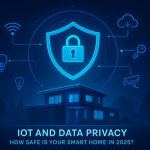Smart devices bring incredible convenience to our lives, but they also introduce potential security risks. Hackers are increasingly targeting IoT devices, exploiting vulnerabilities to gain access to personal data or control over connected systems. Protecting your smart home doesn’t have to be complicated. Here are five practical tips to secure your smart devices and safeguard your privacy.
1. Use Strong, Unique Passwords
Many smart devices come with default passwords that are easily guessed or found online. To secure smart devices:
- Create strong passwords using a mix of uppercase letters, lowercase letters, numbers, and special characters.
- Avoid reusing passwords across multiple devices or accounts.
- Use a password manager to generate and store unique passwords for each device.
Pro Tip: Change the default password on every new device immediately after setup.
2. Enable Two-Factor Authentication (2FA)
Two-factor authentication adds an extra layer of security by requiring a second verification step in addition to your password.
- Look for devices and apps that support 2FA and enable it wherever possible.
- Common methods include receiving a code via text or email, or using an authentication app like Google Authenticator or Authy.
Why It Matters: Even if your password is compromised, 2FA can prevent unauthorized access.
3. Keep Firmware and Software Updated
Manufacturers frequently release updates to fix security vulnerabilities and improve device performance.
- Regularly check for firmware updates on your smart devices and install them promptly.
- Enable automatic updates if the feature is available.
Warning: Outdated software can leave your devices exposed to known exploits.
4. Secure Your Wi-Fi Network
Your Wi-Fi network is the gateway to all your connected devices. Take these steps to secure it:
- Use a strong, unique password for your Wi-Fi network.
- Enable WPA3 encryption, or WPA2 if WPA3 isn’t available.
- Set up a guest network for visitors to keep your main network private.
Extra Measure: Disable SSID broadcasting to make your network less visible to outsiders.
5. Limit Device Permissions and Connectivity
Many smart devices request permissions and features that may not be necessary for their operation.
- Review and restrict app permissions to only what is essential.
- Disable features like remote access or voice control if you don’t use them.
- Disconnect devices from the internet when not in use.
Example: A smart TV may not need microphone or camera access if you don’t use voice commands or video calls.
Securing your smart devices doesn’t require technical expertise—just a proactive approach. By following these five tips, you can protect your devices from cyber threats and enjoy the benefits of a smart home without compromising your privacy or security. Remember, a secure smart home is a smart investment in your peace of mind.
- Designing a Smarter Home in 2026: What People Get Wrong About Automation
 Smart homes were once science fiction, but today they’re a reality in millions of households. With voice assistants, smart plugs, and automated lighting systems, it’s easy to assume home automation is simply a matter of plugging in a few devices. Yet, many homeowners quickly discover that “smart” doesn’t always mean simple. In this article, we’ll…
Smart homes were once science fiction, but today they’re a reality in millions of households. With voice assistants, smart plugs, and automated lighting systems, it’s easy to assume home automation is simply a matter of plugging in a few devices. Yet, many homeowners quickly discover that “smart” doesn’t always mean simple. In this article, we’ll… - Automated Online Trading: How IoT is Redefining Financial Markets
 Introduction automated online trading In a world where milliseconds can decide millions, the fusion of Internet of Things (IoT) technology and automated online trading is reshaping global finance. What once relied solely on human judgment now increasingly depends on connected machines, real-time data, and predictive algorithms. From weather sensors influencing agricultural trades to smart logistics…
Introduction automated online trading In a world where milliseconds can decide millions, the fusion of Internet of Things (IoT) technology and automated online trading is reshaping global finance. What once relied solely on human judgment now increasingly depends on connected machines, real-time data, and predictive algorithms. From weather sensors influencing agricultural trades to smart logistics… - The Role of Linux in IoT: Powering the Connected World
 The Internet of Things (IoT) is everywhere—from smart homes and wearable devices to industrial automation and self-driving cars. Behind the scenes, one operating system plays a surprisingly dominant role: Linux. Known for its stability, flexibility, and open-source nature, Linux has become the backbone of countless IoT devices and platforms. But what makes Linux so well-suited…
The Internet of Things (IoT) is everywhere—from smart homes and wearable devices to industrial automation and self-driving cars. Behind the scenes, one operating system plays a surprisingly dominant role: Linux. Known for its stability, flexibility, and open-source nature, Linux has become the backbone of countless IoT devices and platforms. But what makes Linux so well-suited… - The Smart Home Revolution in 2025: How IoT is Transforming Everyday Living
 In the past decade, the vision of a truly smart home has moved from futuristic fantasy to everyday reality. As we step into 2025, the Internet of Things (IoT) has matured into a robust ecosystem, connecting appliances, security systems, lighting, and even entertainment devices under one seamless digital roof. The result? Homes that are safer,…
In the past decade, the vision of a truly smart home has moved from futuristic fantasy to everyday reality. As we step into 2025, the Internet of Things (IoT) has matured into a robust ecosystem, connecting appliances, security systems, lighting, and even entertainment devices under one seamless digital roof. The result? Homes that are safer,… - IoT and Data Privacy: How Safe Is Your Smart Home in 2025? – IoT Security
 The smart home revolution has made everyday life more convenient than ever. From voice assistants that control the lights to security cameras that send alerts directly to your phone, connected devices have become part of our daily routines. But with this convenience comes an important question: how safe is your personal data in a world…
The smart home revolution has made everyday life more convenient than ever. From voice assistants that control the lights to security cameras that send alerts directly to your phone, connected devices have become part of our daily routines. But with this convenience comes an important question: how safe is your personal data in a world…







